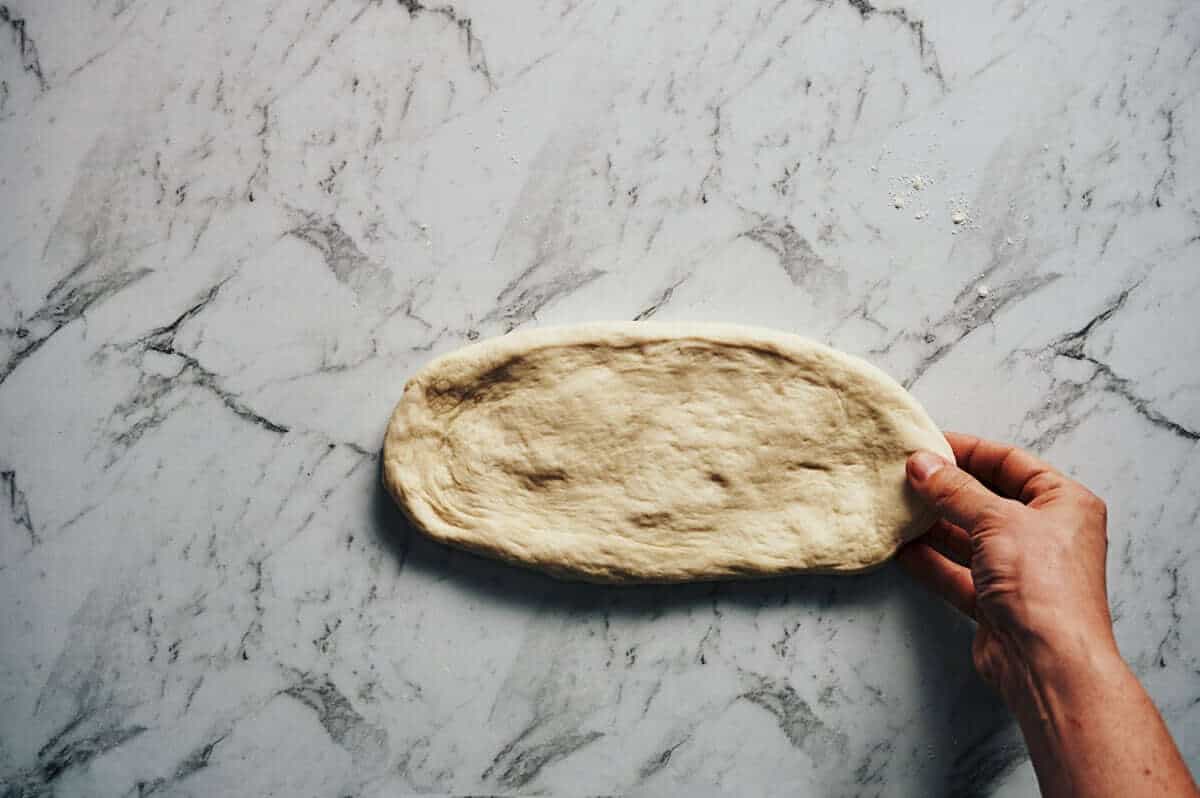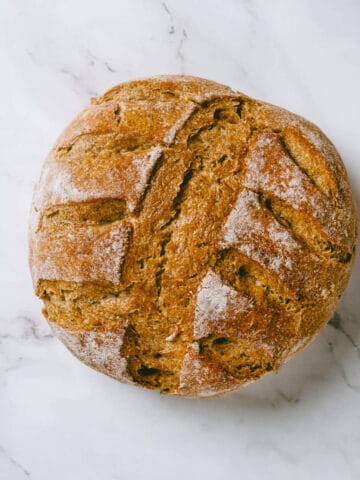Lagana is a traditional Greek flatbread made to celebrate the first day of Lent in the Greek Orthodox tradition. Light, airy and topped with sesame seeds, my lagana recipe is easy to prepare - and virtually foolproof!

CONTENTS
What is lagana?
- Lagana bread is eaten on Kathari Deftera in Greece, which translates as "Clean Monday". It's traditionally served with taramasalata (Greek fish roe dip) along with the semolina based halva dessert. It signifies the beginning of the Lenten period (which lasts for 40 days) and culminates with Easter Sunday celebrations.
- Many people choose to fast during this time and enjoy a diet of Lenten food - abstaining from meat and dairy products.
- The traditional recipe produces unleavened bread made with no raising agents. However, my recipe uses yeast and other basic ingredients to create a soft bread with a distinct chew.
- While it shares a few similarities with Italian focaccia bread, lagana is traditionally topped with sesame seeds.
You will love this
- It has an incredible aroma. This Greek bread is topped with sesame seeds which gives it an extra “nutty” aromatic hit. Your kitchen and house will smell amazing! There’s something about baking bread that really gets people’s attention.
- It’s not heavy or dense. A lot of bread baked at home can turn out like bricks! Has that ever happened to you? Then allow me to guide you and show you how easy it is to bake this. Let your stand mixer do the hard work (or your hands). The dough used to prepare this recipe is soft and elastic, producing a “light and airy” lagana.
- It’s versatile. It doesn’t have to be Lent for you to enjoy this traditional Greek bread. Serve it as a side to your Greek appetizers. Or make it regularly and enjoy it dipped in olive oil or topped with melitzanosalata or htipiti. Just make it!
⭐️ Related: See my Greek Yogurt Flatbread and easy Greek bread recipe for further inspitation.
Ingredients

- Plain flour (all-purpose flour) - helps produce a beautiful crust, and most of us have this flour on hand in our kitchens. If you prefer, you can use bread flour - just increase the water amount by 50ml.
- Instant Dried Yeast - helps our bread rise and gives the lagana its distinct taste.
- Sugar - helps to activate the yeast and give it “life”.
- Lukewarm Water - along with the yeast and sugar, the water needs to be at room temperature. Hot water will kill your yeast. An excellent way to test this is to place your finger in the water- if it’s too hot, the water needs to be cooled slightly.
- Salt - helps to slow down the rate the dough rises. It also helps to strengthen the gluten and modifies the flavour. Flavour is very important to me. Nothing worse than biting into your freshly baked Greek flatbread and discovering it is bland and tasteless.
- Olive oil - helps to make the dough elastic and imparts a subtle aroma. Please try to use the best Greek extra virgin olive oil.
- Sesame Seeds - These are the "signature" ingredient. For our lagana bread to be a “lagana”, it needs white sesame seeds as the topping.
Instructions

Combine the water, yeast, sugar and 1 tablespoon of the oil in a small jug or bowl. Whisk to combine and set aside for 5 minutes until the mixture activates and becomes frothy.

Place the flour and salt in a large bowl for your stand mixer with a dough hook attached. Add the yeast mixture, and at a low speed, let it knead the dough for 10 minutes. Alternatively, you may like to use a wooden spoon to bring everything together and knead the dough on a floured surface.


Once the dough is soft and elastic, drizzle a little olive oil over it and cover the bowl with plastic wrap and a clean kitchen towel. Set aside for 30-45 minutes in a warm place or until doubled in size.
Top Tip: The temperature of your room plays a big part in how long it takes to rise. If it’s on the cooler side, you may need to let it proof a little longer.

Place the risen dough on a floured surface, knead it for a few minutes and divide it into two equal parts.

Take one part of the dough and, using your hands, gently stretch it until it forms a rectangular or oblong shape. Place it on a pre-oiled baking tray (you can use baking paper or parchment paper instead if you prefer). Allow it to rest and proof for another 20 minutes.
Bonus Tip: If you have trouble stretching the lagana by hand, use a rolling pin to help you shape it.



Use your index finger to create little dimples or pockets on the dough, brush the lagana with olive oil and cover generously with sesame seeds.

Bake in a preheated 180 deg C oven until golden brown for 15-20 mins. Allow it to cool for 15 mins and serve warm or at room temperature.

Tips
- Be creative with the toppings. If you don’t follow the Greek Orthodox religion, use the traditional flatbread recipe as a base and experiment with different toppings. Some suggestions include rosemary, olive oil and sea salt or sun-dried tomatoes and olives.
- Getting the sesame seeds to stick. Instead of olive oil, try brushing a minimal amount of honey over the lagana or use a mixture of cornstarch and water to create a “glue”.
- Leftover dough. If you choose to only prepare one flatbread, you can keep the remainder of the dough in a covered bowl in the fridge for 2-3 days. Allow it to come to room temperature before baking and proceed with the recipe instructions. I’ve done this a few times, and let me tell you - the lagana tastes incredible with more pronounced flavours.

More delicious breads
Video - how to make it
📋 Recipe

Lagana - Traditional Greek Flatbread Recipe
Ingredients
- 300 ml water, warm
- 7 grams dry yeast
- 2 teaspoon sugar
- 2 tablespoon olive oil
- 450 grams flour, plain, all purpose
- 2 teaspoon salt
- 2 tablespoon sesame seeds
Instructions
- Combine the water, yeast, sugar and 1 tablespoon of the oil in a small jug or bowl. Whisk to combine and set aside for 5 minutes until the mixture activates and becomes frothy.
- Place the flour and salt in a large bowl for your stand mixer with a dough hook attached. Add the yeast mixture, and at a low speed, let it knead the dough for 10 minutes. Alternatively, you may like to use a wooden spoon to bring everything together and knead the dough on a floured surface.
- Once the dough is soft and elastic, drizzle a little olive oil over it and cover the bowl with plastic wrap and a clean kitchen towel. Set aside for 30-45 minutes in a warm place or until doubled in size.
- Place the lagana dough on a floured surface, knead it for a few minutes and divide it into two equal parts.
- Take one part of the dough and, using your hands, gently stretch it until it forms a rectangular or oblong shape. Place it on a pre-oiled baking tray (you can use baking paper or parchment paper instead if you prefer). Allow it to rest and proof for another 20 minutes.
- Use your index finger to create little dimples or pockets on the dough, brush the lagana with olive oil and cover generously with sesame seeds.
- Bake in a preheated 180 deg C oven until golden brown for 15-20 mins. Allow it to cool for 15 mins and serve warm or at room temperature.
Notes
- Be creative with the toppings. If you don’t follow the Greek Orthodox religion, use the traditional flatbread recipe as a base and experiment with different toppings. Some suggestions include rosemary, olive oil and sea salt or sun-dried tomatoes and olives.
- Getting the sesame seeds to stick. Instead of olive oil, try brushing a minimal amount of honey over the lagana or use a mixture of cornstarch and water to create a “glue”.
- Leftover dough. If you choose to only prepare one flatbread, you can keep the remainder of the dough in a covered bowl in the fridge for 2-3 days. Allow it to come to room temperature before baking and proceed with the recipe instructions. I’ve done this a few times, and let me tell you - the lagana tastes incredible with more pronounced flavours.
Nutrition
This website provides approximate nutrition information for convenience and as a courtesy only. Nutrition data is gathered primarily from the USDA Food Composition Database, whenever available, or otherwise other online calculators.
© Souvlaki For the Soul






Denise
Really enjoyed eating this bread thank you. Had it with dips! Yum!